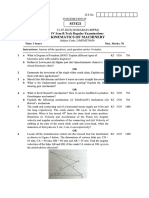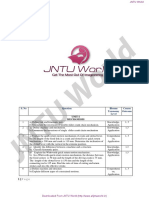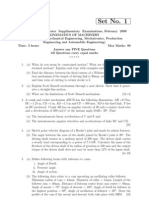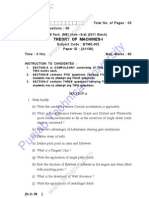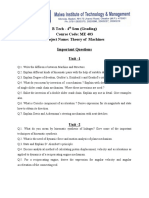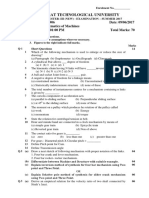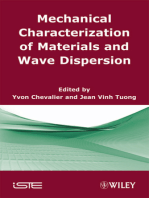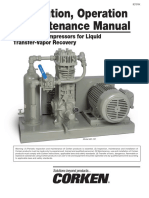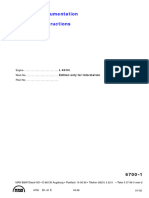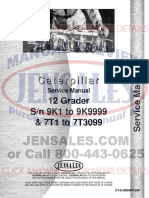2.18MEC222 Theory of Machines I Question Bank
Uploaded by
jayant raikopand2.18MEC222 Theory of Machines I Question Bank
Uploaded by
jayant raikopandSREENIVASA INSTITUTE OF TECHNOLOGY AND MANAGEMENT STUDIES, CHITTOOR.
(AUTONOMOUS)
Department of Mechanical Engineering
(NBA & NAAC Accredited)
II B.Tech II Semester Regulation-R18
THEORY
Of
MACHINES-I
Prepared By
Mr.N.Sathish kumar
Asst.Prof.,
Dept. of Mechanical Engg,
SREENIVASA INSTITUTE OF TECHNOLOGY AND MANAGEMENT STUDIES, CHITTOOR.
(AUTONOMOUS)
Unit-I
PO
Q.No Questions BT
Attainment
Part A (2 marks questions)
Define ‘degrees of freedom’.
1 PO1 R
Classify the constrained motion.
2 PO1 R
3 What are the some important inversions of four chain mechanism? PO1 R
4 What is pantograph? PO2 R
5 What are the applications of single slider crank mechanism? PO1 R
6 Give some examples for kinematics pairs. PO1 R
7 Discuss Elliptical trammel PO1 R
8 What is Movability? PO1 R
9 What is meant by Ackermann steering? PO1 R
10 Write down the Grashof’s Law for a four bar mechanism? PO1 R
Part B (10 marks questions)
a) Describe different types of Link.
PO1 R
1
b) Classify and explain the Kinematic pair.
PO1 R
2 Draw and Describe inversion of four bar chain. PO1 R
3 Explain the inversion of Single Slider Crank Chain. PO1 R
4 Explain the inversion of Double Slider crank chain. PO1 R
a) Explain the offset slider crank mechanism. PO1 R
5
b) Explain Straight line mechanism with neat sketch PO1 R
Describe the working of Oldham’s coupling with a neat sketch and state its
6 PO1,PO2 An
application
7 Discuss the steering gear mechanism with neat sketch. PO1,PO2 An
8 Explain the working of Whitworth quick return mechanism with a neat sketch. PO1,PO2 An
Explain the working of crank and slotted lever quick return motion mechanism
9 PO1,PO2 An
with a neat sketch.
10 Find the degree of freedom of the mechanism shown in fig. PO1,PO2 An
SREENIVASA INSTITUTE OF TECHNOLOGY AND MANAGEMENT STUDIES, CHITTOOR.
(AUTONOMOUS)
Unit-II
Q.No Questions PO BT
Attainment
Part A (2 marks questions)
1 What is kinematic analysis? PO1 R
2 Write down the different types of motion. PO1 R
3 Define Kennedy’s theorem. PO1 R
4 What are properties of instantaneous center? PO1 R
5 What is the difference between velocity and speed PO1 R
6 What is configuration diagram? PO1 R
7 Write the different types of graphical method. PO1 R
8 What is acceleration? PO1 R
9 What is deceleration? PO1 R
10 What is angular velocity ratio theorem? PO1 R
Part B (10 marks questions)
The Crank of a slider crank mechanisms rotates clockwise at a Constant
speed of 300 rpm. The crank is 125 mm and connecting rod is 600 mm PO1,
1 long. Determine 1. Linear velocity and acceleration of the mid-Point of the PO2, U
connecting rod, and 2. Angular velocity and angular acceleration of the PO3
connecting rod, at a crank angle of 45° from inner dead center position.
In a four link mechanism, the dimensions of the links are AB=200 mm,
PO1,
BC=400mm, CD=450 mm and AD=600mm. At the instant when
2 PO2, U
DAB=90°, the link AB has angular velocity of 36 rad/s in the clockwise
PO3
direction. Determine (i) The velocity of point C, (ii) The velocity of point E
SREENIVASA INSTITUTE OF TECHNOLOGY AND MANAGEMENT STUDIES, CHITTOOR.
(AUTONOMOUS)
on the link BC When BE =200 mm (iii) the angular velocities of links BC
and CD, iv) acceleration of link of link BC.
The dimensions of the various links of a mechanism, as shown in fig. are as
follows: OA=300 mm; AB=1200; BC=450 mm and CD=450 mm. if the
PO1,
crank OA rotates at 20 rpm. in the anticlockwise direction and gives motion
3 PO2, U
to the sliding blocks B and D, find, for given configuration: (1)Velocity of
PO3
sliding at B and D, (2) Angular velocity of CD (3) Linear acceleration of D
and (4) angular acceleration of CD.
a)Derive the expressions for Velocity and acceleration of piston in PO1,
4 reciprocating steam engine mechanism with neat sketch b).Derive the PO2, U
expression for Coriollis component of acceleration with neat sketch. PO3
In a slider crank mechanism, the length of the crank and the connecting rod
are 100 mm and 400 mm respectively. The crank [position is 45° from IDC, PO1,
5 the crank shaft speed is 600 rpm. clockwise. Using analytical method PO2, U
Determine (1) Velocity and acceleration of the slider, and (2) Angular PO3
velocity and angular acceleration of the connecting rod.
Locate all instantaneous centers of the slider crank mechanism; the length
of crank OB and Connecting rod AB are 125 mm and 500 mm respectively. PO1,
6 The crank speed is 600 rpm clockwise. When the crank has turned 45° from PO2, U
the IDC. Determine (i) velocity of. Slider’ A’ (ii) Angular Velocity of PO3
connecting rod ‘AB’.
In the mechanism shown in figure, the crank OA rotates at 20 rpm
anticlockwise and gives motion of sliding blocks B and D. The dimensions
PO1,
of various links are OA =300mm, AB = 1200 mm, BC = 450 mm and CD =
7 PO2, U
450 mm. For the given configuration determine i) velocities of sliding at B
PO3
and D, ii) angular velocity of CD iii) Linear acceleration of D and iv)
angular acceleration of CD.
The crank and connecting rod of a theoretical steam engine are 0.5 m and
2m long respectively. The crank makes 180 rpm in the clockwise direction.
When it has turned 450 from the inner dead center position, determine: a)
Velocity of piston b) Angular velocity of connecting rod. C) Velocity of
point E on the connecting rod 1.5m from the gudgeon pin. D) Velocity of
rubbing at the pins of the crank shaft, crank and crank cross head when the
diameters of their pins are 50mm and 60mm and 30mm respectively.
PO1,
8 PO2, U
PO3
The mechanism of a wrapping machine, as shown in fig, has the following
dimensions O1A = 100 mm; AC = 700 mm; BC = 200 mm; O3C = 200 PO1,
9 mm; O2E = 400 mm; O2D = 200 mm and BD = 150mm. The crank O1A PO2, U
rotates at a uniform speed of 100 rad/s. Find the velocity of the point E of PO3
the bell crank lever by instantaneous centre method
SREENIVASA INSTITUTE OF TECHNOLOGY AND MANAGEMENT STUDIES, CHITTOOR.
(AUTONOMOUS)
Unit-III
Q.No Questions PO BT
Attainment
Part A (2 marks questions)
1 What are the different types of belts? PO1 R
2 What type of material used for belts? PO1 R
3 What are the different types of flat belt drives? PO1 R
4 What is centrifugal tension? PO1 R
5 What are the different types of V belt drives? PO1 R
6 What are classification of chains? PO1 R
7 Differentiate between davis and ackerman’s steering gear mechanism? PO1 R
8 Write down maximum and minimum speeds of driven shafts in hook’s joint? PO1 R
Write down condition for equal speeds of the driving and driven shafts in PO1 R
9
hook’s joint?
10 What is maximum fluctuation of speed in hook’s joint? PO1 R
Part B (10 marks questions)
What is the condition for correct steering ? Sketch and show the two main
1 PO1 R
types of steering gearsand discuss their relative advantages
Explain why two Hooke’s joints are used to transmit motion from the engine PO1,
2 An
to the differential of an automobile PO2
Derive an expression for the ratio of shafts velocities for Hooke’s joint and PO1,
3 An
draw the polar diagramdepicting the salient features of driven shaft speed PO2
A Hooke’s joint connects two shafts whose axes intersect at 150°. The driving
shaft rotates uniformly at 120 r.p.m. The driven shaft operates against a steady PO1,
4 torque of 150 N-m and carries a flywheel whose mass is 45 kg and radius of PO2, U
gyration 150 mm. Find the maximum torque which will be exerted by the PO3
driving shaft.
Two shafts are connected by a Hooke’s joint. The driving shaft revolves
PO1,
uniformly at 500 r.p.m. If the total permissible variation in speed of a driven
5 PO2, U
shaft is not to exceed 6% of the mean speed, find the greatest permissible
PO3
angle between the centre lines of the shafts. Also determine the maximum and
SREENIVASA INSTITUTE OF TECHNOLOGY AND MANAGEMENT STUDIES, CHITTOOR.
(AUTONOMOUS)
minimum speed of the driven shaft.
An open belt 100 mm wide connects two pulleys mounted on parallel shafts
with their centres 2.4 m apart. The diameter of the larger pulley is 450 mm
PO1,
and that of the smaller pulley 300 mm. The coefficient of friction between the
6 PO2, U
belt and the pulley is 0.3 and the maximum stress in the belt is limited to 14
PO3
N/mm width. If the larger pulley rotates at 120 r.p.m., find the maximum
power that can be transmitted.
Obtain an expression for the length of a belt in
a) an open belt drive ; and PO1,
7 An
b) Cross belt drive. PO2
PO1,
How does the velocity ratio of a belt drive effect, when some slip is taking
8 PO2, U
place between the belt and the two pulleys ?
PO3
Derive the condition for transmitting the maximum power in a flat belt drive.
PO1,
9 An
PO2
What are different types of chains? Explain, with neat sketches, the power PO1,
10 transmission chains. An
PO2
Unit-IV
Q.No Questions PO BT
. Attainment
o
Part A (2 marks questions)
1 What is a cam? PO1 R
2 Give some examples of cam PO1 R
3 Define tangent cam. PO1 R
4 What ate the different motions of the follower? PO1 R
5 How can high surface stress in flat faced follower be minimized? PO1 R
6 Where are the roller follower extensively used? PO1 R
7 Define dwell period? PO1 R
8 Explain offset follower. PO1 R
9 Define trace point. PO1 R
10 Define pressure angle with respect to cams PO1 R
Part B (10 marks questions)
A cam is to give the following motion to a knife edged follower: a) Outstroke
during 60° of cam rotationb) Dwell for the next 30° of cam rotation c) Return PO1,
1 stroke during next 60° of cam rotation and d) Dwell for the remaining of cam PO2, U
rotation The stroke of the follower is 40 mm and the minimum radius of the PO3
cam is 50 mm. The follower moves with uniform velocity during both the
SREENIVASA INSTITUTE OF TECHNOLOGY AND MANAGEMENT STUDIES, CHITTOOR.
(AUTONOMOUS)
outstroke and return strokes. Draw the profile of the cam when (a) the axis of
the follower passes through the axis of the cam shaft, and (b) the axis of the
follower isoffset by 20 mm from the axis of the cam shaft.
Draw the profile of a cam operating a Knife-edged follower from the following
data: Follower to move outward through 40 mm during 60° of a cam rotation;
( b ) Follower to dwell for the next 45° (c) Follower to return its original
PO1,
position during next 90° (d)Follower to dwell for the rest of cam rotation. The
2 PO2, U
displacement of the follower is to take place with simple harmonic motion
PO3
during both the outward and return strokes. The least radius of the cam is
50mm. If the cam rotates at 300 rpm. determine the maximum velocity and
acceleration of the follower during the outward stroke and return stroke.
A cam, with a minimum radius of 50 mm, rotating clockwise at a uniform
speed, is required to giver a knife-edged follower the motion as described
below: (a) To move outwards through 40 mm during 100° rotation of the cam;
(b) to dwell for next 80° (c) To return to its starting position during next 90°
PO1,
and (d) To dwell for the rest period of revolution. Draw the profile of the cam
3 PO2, U
(i) When the line of stroke of the follower passes through the centre of the cam
PO3
shaft and (ii) When the line of stroke of the follower is to take place with
Uniform acceleration and uniform retardation. Determine the maximum
velocity and acceleration of the follower when the cam shaft rotates at 900
r.p.m.
Draw the profile of a cam operating a roller reciprocating follower and with the
following data: Minimum radius of cam =25 mm; lift=30mm; Roller diameter=
15mm. The cam lifts the follower for 120° with SHM, followed by a dwell PO1,
4 period of 30. Then the follower lowers down during 150° of cam rotation with PO2, U
uniform acceleration and retardation followed by a dwell period. If the cam PO3
rotates at a uniform speed of 150 RPM. Calculate the maximum velocity and
acceleration of follower during the descent period
It is required to set out the profile of a cam to give the following motion to the
reciprocating follower with a flat mushroom contact surface: (i) Follower to
have a stroke of 20 mm during 120° of cam rotation, (ii) Follower to dwell for
50° of cam rotation, (iii) Follower to return to its initial position during 90° of PO1,
5 An
cam rotation, (iv) Follower to dwell for remaining period of cam rotation. The PO2
minimum radius of the cam is 25 mm. The out stroke of the follower is
performed with SHM and return stroke with equal uniform acceleration and
retardation
A tangent cam to drive a roller follower through a total lift of 12.5 mm for a
cam rotation of 75°.The cam speed is 600 rpm. The distance between camcentre
6 and follower centre at full lift is 45 mm and the roller is 20 mm in diameter. PO1 R
Find the cam proportions and plot displacement, velocity and acceleration for
one full cycle.
Construct a tangent cam and mention the important terminologies on it. Also
7 derive the expression for displacement, velocity, acceleration of a reciprocating PO1 R
roller follower when the roller has contact with the nose
Layout the profile of a cam operating a roller reciprocating follower for the
following data. Lift of follower = 30mm; Angle during the follower rise period
PO1,
=1200; angle during the follower after rise = 300; angle during the follower
8 PO2, U
return period = 1500. Angle during which follower dwell after return= 600 ;
PO3
minimum radius of cam = 25mm; Roller diameter =10mm. The motion of
follower is uniform acceleration and deceleration during the rise and return
SREENIVASA INSTITUTE OF TECHNOLOGY AND MANAGEMENT STUDIES, CHITTOOR.
(AUTONOMOUS)
period.
Design a cam to raise a valve with simple harmonic motion through 15mm is
1/3rd of a revolution, keep it fully raised through 1/12th of a revolution and to
lower it with SHM in 1/6th of a revolution. The valve remain closed during the
PO1,
rest of the revolution. The diameter of the roller is 20mm and the minimum
9 PO2, U
radius of the cam is 25mm. The axis of the valve rod passes through the axis of
PO3
the cam shaft. If the cam shaft rotates at uniform speed of 100 rpm; find the
maximum velocity and acceleration of the valve during raising and lowering.
Also draw the profile of the cam.
a) Classify with neat sketches the cam follower according to their shape,
location and motion. State also their advantages, if any, with respect to
PO1,
other followers
10 PO2, U
b) Sketches neatly the displacement, velocity and acceleration curves of a
PO3
cycloidal motion follower. Why is it superior over other motion curves?
Unit-V
PO
Q.No Questions BT
Attainment
Part A (2 marks questions)
1 What is an angle of obliquity in gear? PO1 R
What is bevel gearing? Mention its types.
2 PO1 R
3 What is meant by arc of approach? PO1 R
4 What is meant by arc of recess? PO1 R
5 What is meant by Arc of contact? PO1 R
6 State law of gearing. PO1 R
7 Define normal and axial pitch in helical gears. PO1 R
8 What are the methods to avoid interference? PO1 R
What is the advantage when arc of recess is equal to arc of approach in
9 PO1 R
meshing gears?
Define contact ratio
10 PO1 R
Part B (10 marks questions)
A pinion having 30 teeth drives a gear having 80 teeth. The profile of the
PO1,
gear is involute with 20 degree pressure angle 12 mm module and 10 mm
1 PO2, U
addendum. Find the length of path of contact, arc of contact and the
PO3
contact ratio
SREENIVASA INSTITUTE OF TECHNOLOGY AND MANAGEMENT STUDIES, CHITTOOR.
(AUTONOMOUS)
Two involute gears of 20 degree pressure angle are in mesh. The number
of teeth on pinion is 20 and the gear ratio is 2.If the pitch expressed in
PO1,
module is 5mm and the pitch line speed is 1.2m/s, assuming addendumas
2 PO2, U
standard and equal to one module. Find a).The angle turned through by
PO3
pinion when one pair of teeth is in mesh and b).The maximum velocity of
sliding
A pair of gears having 40 and 20 teeth respectively are rotating in mesh,
the speed of the smaller being 2000 rpm. Determine the velocity of
sliding between the gear teeth faces at the point of engagement, at the PO1,
3 pitch point and at the point of disengagement if the smaller gear is the PO2, U
driver. Assume that the gear teeth are 20 degree involute form, addendum PO3
length is 5mm and the module is 5mm.Also find the angle through which
the pinion turns while any pairs of teeth are in contact.
Two gear wheels mesh externally and are to give a velocity ratio of 3 to
1. The teeth are of involute form; module=6mm, addendum=one module,
pressure angle 20°. The pinion rotates at 90 rpm. Determine (1) the PO1,
4 number of teeth on the pinion to avoid interference on it and the PO2, U
corresponding number of teeth on the wheel, (2) The length of path and PO3
arc of contact, (3) the number of pairs of teeth in contact.(4) Maximum
velocity of sliding
The arm of an epicyclic gear train rotates at 100 rpm in the anticlock wise
direction. The arm carries two wheels A and B having 36 and 45 teeth PO1,
5 respectively. The wheel A is fixed and the arm rotates about the centre of PO2, U
wheel A. Find the speed of wheel B. What will be the speed of B, if the PO3
wheel A instead of being fixed, makes 200 rpm (clockwise).
In a reverted epicyclic train, the arm A carries two gear B and C and a
compound gear D-E. Wheel B meshes with gear E and gear C meshes
PO1,
6 with gear D. The number of teeth on gear B, C and D are 75, 30, and 90. An
PO2
Find the speed and direction of gear C , when gear B is fixed and arm A
makes 100 rpm clockwise
A compound epicyclic gear is shown in figure. The gears A, D and E are
free to rotate on axis P. The compound gears B and C rotate together on
the axis Q at the end of arm F. All the gears have equal pitch. The
number of external teeth on gears, A B and C are 18, 45 and
21respectively. The gears D and E are annulus gears. The gear A rotates
at 100 rpm in anticlockwise direction and the gear D rotates at 450 rpm
clockwise. Find the speed and direction of the arm and the gear E
PO1,
7 PO2, U
PO3
SREENIVASA INSTITUTE OF TECHNOLOGY AND MANAGEMENT STUDIES, CHITTOOR.
(AUTONOMOUS)
The sun planet gear of an epicyclic gear train, the annular D has 100
internal teeth, the sun gear A has 50 external teeth and planet gear B has
PO1,
25 external teeth. The gear B meshes with gear D and gear A. The gear B
8 PO2, U
is carried on arm E, which rotates about the centre of annular gear D. If
PO3
the gear D is fixed and arm rotates at 20 rpm, then find the speeds of gear
A and B.
An epicyclic gear train for an electric motor , is shown in figure. The
wheel S has 15 teeth and is fixed to motor shaft rotating at 1450 rpm. The
planet P has 45 teeth, gears with fixed annular A and rotates on a spindle
carried by an arm which fixed to output shaft. The planet P also gears
with the sun when S. Find the speed of output shaft. If motor is
transmitting 2 KW find the torque required to fix the annular
PO1,
9 PO2, U
PO3
An epicyclic gear train as shown in figure is composed of a fixed annular
wheel A having 150 teeth. The wheel A is meshing with wheel B which
drives wheel D through an idle wheel C, D being concentric with A.
Thewheels B and C are carried on an arm which revolves clockwise at
100 rpm about the axis of A and D. If the wheels B and D have 25 and 40
teeth respectively, determine the number of teeth on C and speed and
sense of rotation of wheel C PO1,
10 PO2, U
PO3
SREENIVASA INSTITUTE OF TECHNOLOGY AND MANAGEMENT STUDIES, CHITTOOR.
(AUTONOMOUS)
UNIT-I
1. Which of the following is an open pair?
a. Journal bearing b. Ball and Socket joint
c. Leave screw and nut d. None of the above
(Ans:c)
2. Which of the following is a higher pair?
a. Turning pair b. Screw pair
c. Belt and pulley d. None of the above
(Ans:c)
3. A higher pair has__________.
a. Point contact b. Surface contact
c. No contact d. None of the above
(Ans:a)
4. In a ball bearing, ball and bearing forms a
a. Turning pair b. Rolling pair c. Screw pair d. Spherical pair
(Ans:b)
5. Which of the following is an inversion of Single slider crank chain?
a. Beam engine b. Rotary engine
c. Oldham’s coupling d. Elliptical trammel
(Ans:b)
6. ________ is an inversion of Double slider crank chain.
a. Coupling rod of a locomotive b. Scotch yoke mechanism
c. Hand pump d. Reciprocating engine
(Ans:b)
7. A ball and a socket forms a
a. Turning pair b. Rolling pair
c. Screw pair d. Spherical pair
(Ans:d)
8. The Kutzbach criterion for determining the number of degrees of freedom (n) is (where l =
number of links, j = number of joints and h = number of higher pairs)
a. n = 3(l-1)-2j-h b. n = 2(l-1)-2j-h
c. n = 3(l-1)-3j-h d. n = 2(l-1)-3j-h
(Ans:a)
9. In reciprocating engine, which of the following restraining body does not exist?
(a) Connecting rod
(b) Crank
(c) Slider
(d) Lever
(Ans:d)
10. A kinematic pair consists of
a. Two links
SREENIVASA INSTITUTE OF TECHNOLOGY AND MANAGEMENT STUDIES, CHITTOOR.
(AUTONOMOUS)
b. Three links
c. Four links
d. Any number of links
(Ans:a)
11. A kinematic pair cannot be classified according to
a. Nature of contact between the links
b. Type of relative motion between the links
c. Nature of mechanical constraints between the links
d. Number of links connected
(Ans:d)
12. Which of the following forms a higher pair?
a.Sliding pair b. Turning pair c. Rolling pair d. Turning pair
(Ans:c)
13. A lower pair has
a. Surface contact
b. Line contact
c. Point contact
d. All of the above
(Ans:a)
14. Ball bearing is an example of
a. Rolling pair b. Sliding pair c. Turning pair d. Spherical pair
(Ans:a)
15. A lower pair has
i. Surface contact
ii. Line contact
iii. Point contact
a. i & ii
b. ii & iii
c. i & iii
d. All of the above
(Ans:b)
16. A rigid body in space has ___ degrees of freedom.
a. Two
b. Three
c. Six
d. Eight
(Ans:c)
17. A double slider kinematic chain has ___ turning pairs and ___ sliding pairs.
a. One, one
b. Two, one
c. Three, one
d. Two, two
(Ans:d)
SREENIVASA INSTITUTE OF TECHNOLOGY AND MANAGEMENT STUDIES, CHITTOOR.
(AUTONOMOUS)
18. A link which makes complete revolution is known as
a. Level
b. Connecting rod
c. Frame
d. Crank
(Ans:d)
19. The fixed link is known as ___ of the mechanism.
a. Level
b. Connecting rod
c. Frame
d. Crank
(Ansc)
20. A four bar kinematic chain has ____ turning pairs
a. One
b. Two
c. Three
d. Four
(Ans:d)
UNIT-II
1. What is the number of instantaneous centres for an eight link mechanism?
a. 15 b. 28 c. 30 d. 8
(Ans:b)
2. Instantaneous center of rotation of a link in a four bar mechanism lies on
a) right side pivot of this link
b) left side pivot of this link
c) a point obtained by intersection on extending adjoining links
d) none of the mentioned (Ans:C)
3. The total number of instantaneous centers for a mechanism of n links is
a) n(n – 1)/2
b) n
c) n – 1
d) n(n – 1)
4. The number of links and instantaneous centers in a reciprocating engine mechanism
are
a) 4,4
b) 4,5
c) 5,4
d) 4,6
5. According to Kennedy’s theorem, if three bodies have plane motions, their
instantaneous centres lie on
a) a triangle
b) a point
SREENIVASA INSTITUTE OF TECHNOLOGY AND MANAGEMENT STUDIES, CHITTOOR.
(AUTONOMOUS)
c) two lines
d) a straight line
6. The velocity of any point in mechanism relative to any other point on the mechanism
on velocity polygon is represented by the line
a) joining the corresponding points
b) perpendicular to line
c) at 450 to line
d) none of the mentioned
7. Tangential acceleration direction is
a) along the angular velocity
b) opposite to angular velocity
c) perpendicular to angular velocity
d) all of the mentioned
8. In a lifting machine, the effort required to lift loads of 200N and 300N were 50N and
60N respectively. If the velocity ratio of the machine is 20 determine efficiency to
load of 300 N.
a) 10 %
b) 15 %
c) 20 %
d) 25 %
9. A machine raised a load of 360 N through a distance of 200 mm. The effort, a force of
60 N moved 1.8 m during the process. Calculate effect of friction.
a) 10 N
b) 20 N
c) 30 N
d) 40 N
10. The instantaneous centre is a point which is always fixed.
a) True
b) False
11. The angular velocity of a rotating body is expressed in terms of
a) revolution per minute
b) radians per second
c) any one of the mentioned
d) none of the mentioned
12. The relation between linear velocity and angular velocity of a cycle
a) exists under all conditions
b) does not exist under all conditions
c) exists only when it does not slip
d) exists only when it moves on horizontal plane
13. The linear velocity of a point B on a link rotating at an angular velocity ω relative to
another point A on the same link is
a) ω2AB
b) ωAB
c) ω(AB)2
d) ω/AB
14. The instantaneous centers of a slider moving in a linear guide lies at
a) pin joints
b) their point of contact
SREENIVASA INSTITUTE OF TECHNOLOGY AND MANAGEMENT STUDIES, CHITTOOR.
(AUTONOMOUS)
c) infinity
d) none of the mentioned
15. For the same crank length and uniform angular velocity of the crank in an offset slider
crank mechanism, if the connecting rod length is increased by 1.5 times, the velocity
of piston will
a) remain unchanged
b) increase 1.5 times
c) decrease by 1.5 times
d) increase by 1.5√2 times
16. The fixed instantaneous center of mechanism
a) varies with the configuration
b) remains at the same place for all configurations
c) all of the mentioned
d) none of the mentioned
17. The locus of instantaneous center of a moving body relative to a fixed body is known
as the
a) space centrode
b) body centrode
c) moving centrode
d) none of the mentioned
18. The component of the acceleration directed towards the center of rotation of a
revolving body is known as ____________ component.
a) tangential
b) centripetal
c) coriolis
d) none of the mentioned
19. The space centrode of a circular disc rolling on a straight path is
a) circle
b) parabola
c) a straight line
d) none of the mentioned
20. The instantaneous centers of a slider moving in a curved surface lies at
a) infinity
b) their point of contact
c) the center of curvature
d) the pin point
UNIT-III
1. The velocity ratio of two pulleys connected by an open belt or crossed belt is
a) directly proportional to their diameters
b) inversely proportional to their diameters
c) directly proportional to the square of their diameters
d) inversely proportional to the square of their diameters
2. . Two pulleys of diameters d1 and d2 and at distance x apart are connected by means
of an open belt drive. The length of the belt is
a) π /2 (d1 + d2) 2x + (d1 + d2)2/4x
b) π /2 (d1 – d2) 2x + (d1 – d2)2/4x
c) π /2 (d1 + d2) 2x + (d1 – d2)2/4x
d) π /2 (d1 – d2) 2x + (d1 + d2)2/4x
SREENIVASA INSTITUTE OF TECHNOLOGY AND MANAGEMENT STUDIES, CHITTOOR.
(AUTONOMOUS)
3. Due to slip of the belt, the velocity ratio of the belt drive
a) decreases
b) increases
c) does not change
d) none of the mentione
4. The power transmitted by a belt is maximum when the maximum tension in the belt
(T) is equal to
a) TC
b) 2TC
c) 3TC
d) 4TC
5. The velocity of the belt for maximum power is
a) √T/3m
b) √T/4m
c) √T/5m
d) √T/6m
6. The centrifugal tension in belts
a) increases power transmitted
b) decreases power transmitted
c) have no effect on the power transmitted
d) increases power transmitted upto a certain speed and then decreases
7. When the belt is stationary, it is subjected to some tension, known as initial tension.
The value of this tension is equal to the
a) tension in the tight side of the belt
b) tension in the slack side of the belt
c) sum of the tensions in the tight side and slack side of the belt
d) average tension of the tight side and slack side of the belt
8. Due to slip of belt, the velocity ratio of the belt drive increases.
a) True
b) False
9. When two pulleys of different diameters are connected by means of an open belt, the
angle of contact at the _________pulley must be taken into consideration.
a) smaller b) larger c) medium d) none of the mentioned
10. The power transmitted by a belt is maximum when the maximum tension in the belt is
__________of centrifugal tension.
a) one-third b) two-third c) double d) three times
11. The centrifugal tension on the belt has no effect on the power transmitted.
a) True
b) False
12. The wire ropes make contact at
a) bottom of groove of the pulley
b) sides of groove of the pulley
c) sides and bottom of groove of the pulley
d) any where in the groove of the pulley
13. The creep in a belt drive is due to the
a) material of the pulleys
b) material of the belt
c) unequal size of the pulleys
d) unequal tension in tight and slack sides of the belt
14. The creep in a belt drive is due to the
a) material of the pulleys
SREENIVASA INSTITUTE OF TECHNOLOGY AND MANAGEMENT STUDIES, CHITTOOR.
(AUTONOMOUS)
b) material of the belt
c) unequal size of the pulleys
d) unequal tension in tight and slack sides of the belt
15. The distance between the hinge centre of a link and the corresponding hinge centre of
the adjacent link is called
a) pitch of the chain
b) bush roller chain
c) block chain
d) none of the mentioned
16. Which one of the following is a positive drive?
a) Crossed flat belt drive
b) Rope drive
c) V-belt drive
d) Chain drive
17. Which one of the following is a positive drive?
a) Crossed flat belt drive
b) Rope drive
c) V-belt drive
d) Chain drive
18. The relation between the pitch of the chain (p) and pitch circle diameter of the
sprocket (D) is given by
a) p = D sin(900/T)
b) p = D sin(1200/T)
c) p = D sin(1800/T)
d) p = D sin(3600/T)
19. The speed of the sprocket reduces as the chain pitch _____________ for a given
number of teeth.
a) increases b) decreases c) remains same d) none of the mentioned
20. The ratio of the driving tensions for V-belts is _____________ times that of flat belts.
a) sin β b) cos β c) cosec β d) sec β
UNIT-IV
1. The size of a cam depends upon
a) base circle b) pitch circle c) prime circle d) pitch curve
2. The angle between the direction of the follower motion and a normal to the pitch curve is
called
a) pitch angle b) prime angle c) base angle d) pressure angle
3. The cam follower generally used in automobile engines is
a) knife edge follower
b) flat faced follower
c) spherical faced follower
d) roller follower
4. Ofset is provided to a cam follower mechanism to
a) minimise the side thrust
b) accelerate
c) avoid jerk
d) none of the mentioned
5. For high speed engines, the cam follower should move with
a) uniform velocity
b) simple harmonic motion
SREENIVASA INSTITUTE OF TECHNOLOGY AND MANAGEMENT STUDIES, CHITTOOR.
(AUTONOMOUS)
c) uniform acceleration and retardation
d) cycloidal motion
6. Which of the following displacement diagrams should be chosen for better dynamic
performance of a cam-follower mechanism ?
a) simple hormonic motion
b) parabolic motion
c) cycloidal motion
d) none of the mentioned
7. The retardation of a flat faced follower when it has contact at the apex of the nose of a
circular arc cam, is given by
a) ω2×OQ b) ω2×OQsinθ c) ω2×OQcosθ d) ω2×OQtanθ
8. For low and moderate speed engines, the cam follower should move with
a) uniform velocity
b) simple harmonic motion
c) uniform acceleration and retardation
d) cycloidal motion
9. Angle of action of cam is defined as the angle
a) of rotation of the cam for a definite displacement of the follower
b) through which the cam rotates during the period in which the follower remains in the
highest position
c) moved by the cam from the instant the follower begins to rise, till it reaches its highest
position
d) moved by the cam from beginning of ascent to the termination of descent
10. The cam follower generally used in aircraft engines is
a) knife edge follower
b) flat faced follower
c) spherical faced follower
d) roller follower
11. The cam follower generally used in aircraft engines is
a) knife edge follower
b) flat faced follower
c) spherical faced follower
d) roller follower
UNIT – V
1. The size of a gear is usually specified by
a) pressure angle
b) circular pitch
c) diametral pitch
d) pitch circle diameter
2. The radial distance of a tooth from the pitch circle to the bottom of the tooth, is called
a) dedendum
b) addendum
c) clearance
d) working depth
3. The product of the diametral pitch and circular pitch is equal to
a) 1
b) 1/π
SREENIVASA INSTITUTE OF TECHNOLOGY AND MANAGEMENT STUDIES, CHITTOOR.
(AUTONOMOUS)
c) π
d) 2π
4. The contact ratio for gears is
a) zero
b) less than one
c) greater than one
d) none of the mentioned
5. he maximum length of arc of contact for two mating gears, in order to avoid
interference, is
a) (r + R) sin φ
b) (r + R) cos φ
c) (r + R) tan φ
d) none of the mentioned
6. Involute profile is preferred to cyloidal because
a) the profile is easy to cut
b) only one curve is required to cut
c) the rack has straight line profile and hence can be cut accurately
d) none of the mentioned
7. Law of gearing is satisfied if
a) two surfaces slide smoothly
b) common normal at the point of contact passes through the pitch point on the line
joining the centres of rotation
c) number of teeth = P.C.D. / module
d) addendum is greater than dedendum
8. When the axes of first and last gear are co-axial, then gear train is known as
a) simple gear train
b) compound gear train
c) reverted gear train
d) epicyclic gear train
9. A differential gear in an automobile is a
a) simple gear train
b) epicyclic gear train
c) compound gear train
d) none of the mentioned
10. The type of gears used to connect two non parallel and non intersecting shafts is
a) Spur gear
b) Helical gear
c) Bevel gear
d) Spiral gear
11. Which gear train is used for higher velocity ratios in a small space?
a) Simple gear train
b) Compound gear train
c) Reverted gear train
d) Epicyclic gear train
12. The gear used to convert rotary motion into translating motion is
a) Worm and wheel
b) Crown gear
c) Rack and pinion
d) Spiral Bevel gear
13. The contact ratio is given by
a) Length of the path of approach/Circular pitch
SREENIVASA INSTITUTE OF TECHNOLOGY AND MANAGEMENT STUDIES, CHITTOOR.
(AUTONOMOUS)
b) Length of the path of recess/Circular pitch
c) Length of the arc of contact/Circular pitch
d) Length of the arc of approach/cosɸ
14. In helical gears, the right hand helices on one gear will mesh ____________ helices
on the other gear.
a) right hand
b) left hand
c) opposite
d) none of the mentioned
15. Bevel gears with shafts angle of 900 are termed as
a) zerol gears
b) angular bevel gears
c) mitre gears
d) hypoid gears
16. . The axial thrust on the worm (WA) is given by
a) WA = WT .tan φ
b) WA = WT / tan φ
c) WA = WT . tan λ
d) WA = WT / tan λ
17. The angle, at the base cylinder of an involute gear, that the tooth makes with the gear
axis is known as
a) pressure angle
b) base helix angle
c) roll angle
d) none of the mentioned
18. In skew bevel gears, the axes are
a) non-parallel and non-intersecting, and teeth are curved
b) non-parallel and non-intersecting, and teeth are straight
c) intersecting, and teeth are curved and oblique
d) intersecting, and teeth are curved and can be ground
19. A planetary gear train is gear train having
a) a relative motion of axes and the axis of at least one of the gears also moves
relative to the frame
b) no relative motion of axes and no relative motion of axes with respect to the frame
c) no relative motion of axes and the axis of at least one of the gears also moves
relative to the frame
d) a relative motion of axes and none of the axes of gears has relative motion with the
frame
20. The tooth profile most commonly used in gear drives for power transmission is
a) A cycloid
b) An involute
c) An ellipse
d) A parabola
You might also like
- 974-0753 Onan RDJC RDJF Diesel Engine Service Manual (09-1984)100% (1)974-0753 Onan RDJC RDJF Diesel Engine Service Manual (09-1984)64 pages
- Engine Guideline Engine Guideline: Engine Mechanical F8B EngineNo ratings yetEngine Guideline Engine Guideline: Engine Mechanical F8B Engine42 pages
- Our Official Android App - REJINPAUL NETWORK FromNo ratings yetOur Official Android App - REJINPAUL NETWORK From3 pages
- Kinematics of Machinery Question Bank PDFNo ratings yetKinematics of Machinery Question Bank PDF5 pages
- EMG 2208 - Mechanics of Machines - Assignment - MMU Sept 2012No ratings yetEMG 2208 - Mechanics of Machines - Assignment - MMU Sept 20124 pages
- Marks:: 3. (A) in (I) (Ir) (Iir) Rod. (B) TheoremNo ratings yetMarks:: 3. (A) in (I) (Ir) (Iir) Rod. (B) Theorem3 pages
- Punjab Technical University: Theory of Machines-INo ratings yetPunjab Technical University: Theory of Machines-I3 pages
- Diploma-4 Sem Course Code: 403 Subject Name: Theory of Machines Important QuestionsNo ratings yetDiploma-4 Sem Course Code: 403 Subject Name: Theory of Machines Important Questions6 pages
- Question Bank _ 10 Mark _ MEPC 503 Theory of MachinesNo ratings yetQuestion Bank _ 10 Mark _ MEPC 503 Theory of Machines4 pages
- B Tech - 4 Sem (Grading) Course Code: ME 403 Subject Name: Theory of Machines Important Questions Unit - 1No ratings yetB Tech - 4 Sem (Grading) Course Code: ME 403 Subject Name: Theory of Machines Important Questions Unit - 16 pages
- Valliammai Engineering College Department of Mechanical Engineering Me6401-Kinematics of Machinery Question BankNo ratings yetValliammai Engineering College Department of Mechanical Engineering Me6401-Kinematics of Machinery Question Bank11 pages
- SE SEM IV MECH TOM & M Apr-May 2022 ME209No ratings yetSE SEM IV MECH TOM & M Apr-May 2022 ME2093 pages
- Test No 01: Subject: - Theory of Machines Max Marks 100 Time 3 HourNo ratings yetTest No 01: Subject: - Theory of Machines Max Marks 100 Time 3 Hour4 pages
- Theory of Machine & Mechanisms 2019(Even)No ratings yetTheory of Machine & Mechanisms 2019(Even)6 pages
- Theory of Machines-I (MAE218) - Minor Exam and SolutionNo ratings yetTheory of Machines-I (MAE218) - Minor Exam and Solution33 pages
- MME 2323-Mechanics of Machines April 2019 Marking SchemeNo ratings yetMME 2323-Mechanics of Machines April 2019 Marking Scheme18 pages
- VTU BE ME IV Sem Kinematics of Machines Papers From 2002 2018No ratings yetVTU BE ME IV Sem Kinematics of Machines Papers From 2002 201865 pages
- Ilovepdf - Merged - 2024-02-25T160505.161No ratings yetIlovepdf - Merged - 2024-02-25T160505.1617 pages
- 22438-2023-Winter-Question-Paper (Msbte Study Resources)No ratings yet22438-2023-Winter-Question-Paper (Msbte Study Resources)4 pages
- WWW - Manaresults.Co - In: II B. Tech II Semester Supplementary Examinations, November - 2018 Kinematics of MachinaryNo ratings yetWWW - Manaresults.Co - In: II B. Tech II Semester Supplementary Examinations, November - 2018 Kinematics of Machinary2 pages
- Advanced Electric Drives: Analysis, Control, and Modeling Using MATLAB / SimulinkFrom EverandAdvanced Electric Drives: Analysis, Control, and Modeling Using MATLAB / SimulinkNo ratings yet
- Robot Manipulators: Modeling, Performance Analysis and ControlFrom EverandRobot Manipulators: Modeling, Performance Analysis and ControlNo ratings yet
- Mechanical Characterization of Materials and Wave Dispersion: Instrumentation and Experiment InterpretationFrom EverandMechanical Characterization of Materials and Wave Dispersion: Instrumentation and Experiment InterpretationYvon ChevalierNo ratings yet
- Handbook of Defence Electronics and Optronics: Fundamentals, Technologies and SystemsFrom EverandHandbook of Defence Electronics and Optronics: Fundamentals, Technologies and SystemsNo ratings yet
- Bom A03381l310.20.29.2039 15823048 0010 1013193604 - 001No ratings yetBom A03381l310.20.29.2039 15823048 0010 1013193604 - 0011 page
- Basic Components of Internal Combustion EnginesNo ratings yetBasic Components of Internal Combustion Engines62 pages
- Mini Project Sample Report Format - 2022-2026 - BatchNo ratings yetMini Project Sample Report Format - 2022-2026 - Batch41 pages
- A Textbook of Automobile Engineering by Navy Feroz100% (2)A Textbook of Automobile Engineering by Navy Feroz161 pages
- Vespa LX - S 125 3v Ie 150 3v Ie MY 2012 (EN)100% (2)Vespa LX - S 125 3v Ie 150 3v Ie MY 2012 (EN)251 pages
- Installation Operation Maintenance Instruction: Manufacturers of Quality Pumps, Controls and SystemsNo ratings yetInstallation Operation Maintenance Instruction: Manufacturers of Quality Pumps, Controls and Systems56 pages
- Caterpillar Grader Service Manual CT S GRDR 129kNo ratings yetCaterpillar Grader Service Manual CT S GRDR 129k9 pages
- Baw-Pickup Parts Catalog-Bj2034hht42 220425No ratings yetBaw-Pickup Parts Catalog-Bj2034hht42 22042596 pages

















